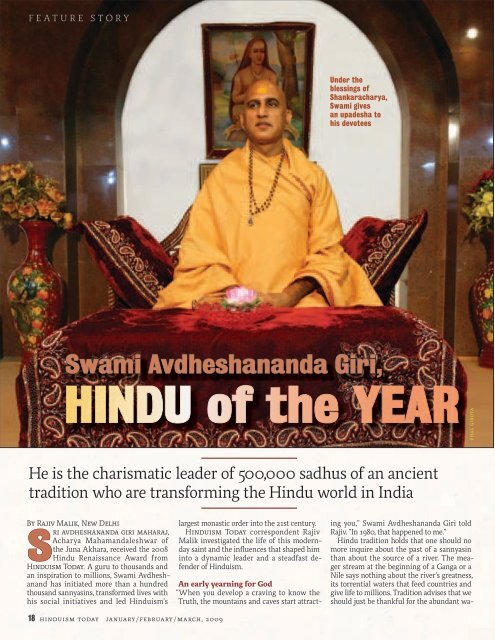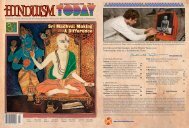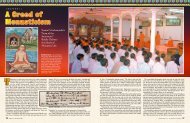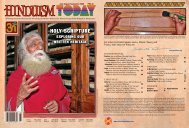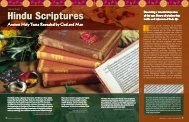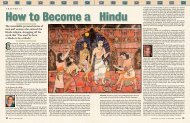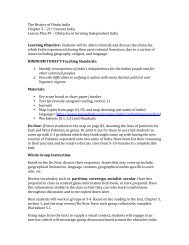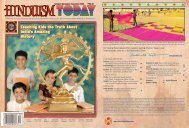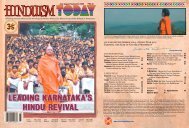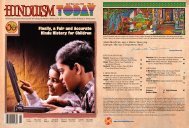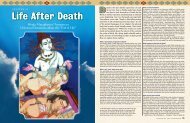Hinduism Today January 2009 - Cover, Index, Front Articles
Hinduism Today January 2009 - Cover, Index, Front Articles
Hinduism Today January 2009 - Cover, Index, Front Articles
You also want an ePaper? Increase the reach of your titles
YUMPU automatically turns print PDFs into web optimized ePapers that Google loves.
feature storydinodiaHe is the charismatic leader of 500,000 sadhus of an ancienttradition who are transforming the Hindu world in IndiaBy Rajiv Malik, New DelhiSri avdheshananda giri maharaj,Acharya Mahamandaleshwar ofthe Juna Akhara, received the 2008Hindu Renaissance Award from<strong>Hinduism</strong> <strong>Today</strong>. A guru to thousands andan inspiration to millions, Swami Av dheshanandhas initiated more than a hundredthousand sannyasins, transformed lives withhis social initiatives and led <strong>Hinduism</strong>’slargest monastic order into the 21st century.<strong>Hinduism</strong> <strong>Today</strong> correspondent RajivMalik investigated the life of this moderndaysaint and the influences that shaped himinto a dynamic leader and a steadfast defenderof <strong>Hinduism</strong>.Under theblessings ofShankaracharya,Swami givesan upadesha tohis devoteesSwami Avdheshananda Giri,HINDU of the YEARAn early yearning for God“When you develop a craving to know theTruth, the mountains and caves start attractingyou,” Swami Avdheshananda Giri toldRajiv. “In 1980, that happened to me.”Hindu tradition holds that one should nomore inquire about the past of a sannyasinthan about the source of a river. The meagerstream at the beginning of a Ganga or aNile says nothing about the river’s greatness,its torrential waters that feed countries andgive life to millions. Tradition advises that weshould just be thankful for the abundant waphal girotaters. But when a sannyasin does talk abouthis path, it is to encourage others and inspireseekers. Last year, during the Guru Purnimacelebrations in New Delhi, Swami Avdheshanandashared with our reporter some of thesteps of his quest.Swami remembers that it was the year1980 in northern India when an unusuallyinquisitive young man arrived at conclusionsthat would later guide his spiritual progress.He realized he did not understand life,nor did those around him. He longed for atruth that, he reasoned, could only be foundat the feet of those no longer influenced bythe world. Thus began his search for a satpurusha,a soul who had realized the Truth.Wandering for months at the lower rangesof the Himalayas, the seeker realized heneeded a teacher to guide him, one who wasspiritually awake and blessed close connectionwith God. The young man, who wouldone day become Swami Avdheshananda,found his guru: Swami Avadhoot Prakash,a rare and elderly sage, expert in yoga andlearned in the ancient sacred Hindu texts.Under the master’s tutelage, in the coldfoothills of North India, he studied the scripturesand developed a taste for Sanskrit, thelanguage of the Gods. Eventually he receivedfrom his first formal initiation (diksha) as anaishtika brahmachari, opening doors todeeper yoga practices and confirming his aspirationto one day renounce the world.His resolve was soon tested when SwamiAvadhoot Prakash Ji Maharaj left his mortalform. The young novice did not falter. Hecontinued his practices and inner achievements,having faith that he remained underThe HinduRenaissance AwardThe Hindu Renaissance Award was createdin 1991 by the founder of <strong>Hinduism</strong><strong>Today</strong> to recognize and strengthenHindu leaders worldwide. Swami AvdheshanandaGiri was presented the awardin August, 2008, at a grand satsang duringhis visit to the Sunnyvale Hindu Temple inCalifornia. <strong>Hinduism</strong> <strong>Today</strong>’s representative,Easan Katir, gave the following short addressexplaining the award’s spirit, its history andthe choice of this year’s awardee.The Hindu Renaissance Award is given by<strong>Hinduism</strong> <strong>Today</strong> magazine to leaders whoinspire, strengthen and reinvigorate <strong>Hinduism</strong> and its millions offollowers all over the globe,” Easan Katir explained. “Such peerlessleaders can come in many forms, reflecting the diverse ways of ourfaith. Some are silent sages, mystics who take us to the heights of ourown being by the force their own enlightenment. Others are tirelesssocial workers, servants of Hindus in need, helping children, priests,villages, the sick and the poor, living the Hindu ideals of ahimsa andthe protection of God and guru.In 1985 a very different, matured manemerged from the sacred caves. The yogiapproached the revered Swami SatyamitranandaJi Maharaj of Bharat Mata Mandir,a beloved former teacher. From Swamiji hereceived sannyas diksha, entering his newbrotherhood, the holy Juna Akhara, <strong>Hinduism</strong>’slargest order of renunciate monastics.Until now, he had been free and detached,an inner explorer, who gave little thought tothe external world. But after donning thekavi robes of the sannyasin, he became ateacher. Accustomed to the practice of mauna(silence), he had little idea how importanthis lectures would become to so many.Spending more and more time in teachingand social work, he became convinced thathe must become an agent of social reform,not just social help. This, he saw, had to bedone through the transformation of the individual,based on the precepts laid downby Hindu saints of yore. Swamiji became akatha vachak of the Juna Akhara—a speakerand storyteller—traveling almost incessantlyinside India and abroad. The katha vachakis a master of Ram katha, employing stories,drama, music and debate to elucidatereligious concepts. He must be able to speakfor hours, keeping the audience immersed inthe performance, entranced and spirituallyuplifted. The best katha vachaks are famousin the Hindu world, the likes of Morari Bapuand Rameshbai Oza, but few are renunciatesadhus. In his first years as a Ram kathaka,Swami’s gift for oratory and his inborn claritysoon earned him the respect and love ofeager seekers around the world.A gifted speakerRajiv Pratap Rudy, 52, a former high-rankingofficial for India’s aviation industry, explained,“Swamiji is able to strongly influenceus, the common people, whether it isa youth or a senior housewife. He interactswith us not only about religion, but about allof our lives and interests. Swami speaks in amodern manner, but rooted in tradition.”Many felt an instant connection withthe new katha vachak in the late 1980s andearly 1990s. The young sannyasin graduallybecame popular as a guest and a speaker.Swami told <strong>Hinduism</strong> <strong>Today</strong> that duringthose years he was quietly training himselfto live more attuned to the ancient teachingsof <strong>Hinduism</strong>, deepening his study of karmaand spiritual laws, undergoing a transformationthat would strengthen his convictionthat seva, selfless service, is the core of whata spiritual aspirant should do today.In 1998, Swami’s role as a world-travelingteacher reached a peak. Around the sametime, the Acharya Mahamandaleshwar ofthe akhara, the highest leader of the order,passed away. Though a few saintly renunciatescarry the title of Mahamandaleshwar—which translates as “supervisor of manymonks”—only one is the Acharya. The positionis not one of absolute authority, but ratherof deep respect. The acharya is the publicface of the time-honored organization. Heguides the spirit of the akhara’s activities andinitiates all new sannyasins joining the order.Swami Avadheshanda recalls, “In 1998,the Juna Akhara formally decided to makeme one of the Mahamandaleshwars. Therewas a formal ceremony and a religious ritual,compassion. Yet others are scholars,intellectual champions capable ofdebating deep scriptural truths andfighting in many arenas to protectdharma. This year’s recipient belongsto more than one of these categories.Swami Avdheshananda Giri Maharajwas chosen the Acharya Mahamandaleshwarof the holy Juna Akharaand has excelled at the task.”Previous awardees were SwamiParamananda Bharati (’90), SwamiChidananda Saraswati (’91), SwamiChinmayananda (’92), Mata Amritanandamayi Ma (’93), SwamiSatchidananda (’94), Pramukhswami Maharaj (’95), Satya Sai Baba(’96), Sri Chinmoy (’97), Swami Bua (’98), Swami Chidananda Saraswatiof Divine Life Society (’99), Ma Yoga Shakti (’00), T. S. SambamurthySivachariar (’01), Dada Vaswani (’02), Sri Tiruchi Mahaswamigal (’03),Dr. K. Pichai Sivacharya (’04), Swami Tejomayananda (’05), RameshBhai Oza (’06) and Sri Balagandharanathaswami (’07).18 hinduism today january/february/march, <strong>2009</strong> january/february/march, <strong>2009</strong> hinduism today 19


